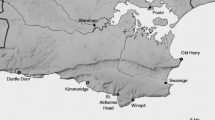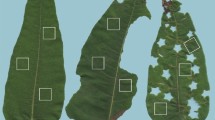Abstract
This paper presents tests of a model of wound-induced defence in herbaceous plants. Many studies have reported both chemical changes in leaves and changes in the behaviour and/or physiology of herbivores as a result of wounding leaves. These studies and others have led to the development of various models to explain wound-induced effects both in terms of plant response and herbivore behaviour. The model under test was proposed by Edwards and Wratten (1987) and predicts that wounding a plant will cause herbivores (1) to take more meals of a smaller size and/or consume less foliage overall (2) grow more slowly and (3) be more mobile. These predictions were tested in cabbage Brassica oleracea L. var. Capitata cv. Pixie with Pieris brassicae L. (Lepidoptera: Pieridae) as a herbivore specialising on cabbage, and Spodoptera littoralis Boisd. (Lepidoptera: Noctuidae) as a generalist herbivore. Both insects showed some reduction in consumption of leaves from upper parts of the plant, but no change in meal size. There were no effects on the growth or mobility of either species as a result of wounding foliage. These results are discussed in relation to the predictions of the model.
Similar content being viewed by others
References
Baldwin IT (1990) Herbivory simulations in ecological research. Trends Ecol Evol 5:91–93
Baldwin IT, Schmelz EA (1994) Constraints on an induced defence: the role of leaf area. Oecologia 97:424–430
Barbosa P (1988) Natural enemies and herbivore-plant interactions: Influence of plant allelochemicals and host specificity. In: Barbosa P, Letourneau DK (eds) Novel aspects of insectplant interactions. Wiley, New York, pp 201–209
Barker AM (1992) Wound-induced chemical changes in plants and their effects on the behaviour of insect herbivores. Ph.D. thesis, University of Southampton
Barker AM, Wratten SD, Edwards PJ (1995) Wound-induced changes in tomato leaves and their effects on feeding patterns of larval Lepidoptera. Oecologia 101:251–257
Bergelson JM, Lawton JH (1988) Does foliage damage influence predation on the insect herbivores of birch? Ecology 69:434–445
Birch ANE, Griffiths DW and Macfarlane Smith WH (1990) Changes in forage and oilseed rape (Brassica napus) root glucosinolates in response to attack by turnip root fly (Delia floralis). J Sci Food Agric 51:321–335
Blaakmeyer A, Geervliet JBF, Van Loon JJA, Posthumus MA, Van Beek TA, Groot Ae de (1994) Comparative headspace analysis of cabbage plants damaged by two species of Pieris caterpillars: consequences for in-flight host location by Cotesia parasitoids. Entomol Exp Appl 73:175–182
Bodnaryk RP (1992) Effects of wounding in cotyledons of oilseed rape and mustard. Phytochemistry 31:2671–2677
Broadway RM, Duffey SS, Pearce G, Ryan CA (1986) Plant proteinase inhibitors: a defence against herbivorous insects? Entomol Exp Appl 41:33–38
Carter DJ, Holloway JD (1987) Immature stages. In: Betts CR (ed) CIE guides to insects of importance to man. 1. Lepidoptera. CAB International, Oxford, pp 189–227
Croxford AC, Edwards PJ, Wratten SD (1989) Temporal and spatial variation in palatability of soybean and cotton leaves following wounding. Oecologia 79:520–525
David WAL, Gardiner BOC (1952) Laboratory breeding of Pieris brassicae L. and Apanteles glomeratus L. Proc R Entomol Soc Lond A 27:54–46
Edwards PJ, Wratten SD (1987) Ecological significance of wound induced changes in plant chemistry. In: Labeyrie V, Farbes G, Lachaise D (eds.) Insects-plants (Proceedings of 6th International Symposium on Insect-Plant Relationships, Pau 1986) Junk, Dordrecht, pp 213–218
Edwards PJ, Wratten SD, Cox H (1985) Wound-induced changes in the acceptability of tomato to larvae of Spodoptera littoralis: a laboratory bioassay. Ecol Entomol 10:155–158
Edwards PJ, Wratten SD, Greenwood SD (1986) Palatability of British trees to insects — constitutive and induced defences. Oecologia 69:316–319
Edwards P, Wratten SD, Gibberd RM (1991) The impact of inducible phytochemicals on food selection by insect herbivores and its consequences for the distribution of grazing damage. In: Tallamy DW, Raupp MJ (eds) Phytochemical induction by herbivores. Wiley, New York, pp 202–222
Edwards P, Wratten SD, Parker EA (1992) The ecological significance of rapid wound induced changes in plants: insect grazing and plant competition. Oecologia 91:266–272
Feltwell J (1982) The biology, biochemistry and physiology of Pieris brassicae (Linnaeus). (Series Entomologica 18). Junk, The Hague
Fowler SV, Lawton JH (1985) Rapidly induced defences and talking trees: the devil's advocate position. Am Nat 126:181–195
Fowler SV, Macgarvin M (1986) The effects of leaf damage on the performance of insect herbivores on birch, Betula pubescens. J Anim Ecol 55:565–573
Gibberd R (1987) Wound-induced plant responses and their consequences for insect grazing. Ph.D. Thesis, University of Southampton
Gibberd R, Edwards PJ, Wratten SD (1988) Wound induced changes in the acceptability of tree foliage to Lepidoptera: within-leaf effects. Oikos 51:43–47
Green TR, Ryan CA (1972) Wound-induced proteinase inhibitor in tomato leaves: a possible defence mechanism against insects. Science 175:776–777
Green TR, Ryan CA (1973) Wound-induced proteinase inhibitor in tomato leaves. Plant Physiol 51:19–21
Hartley SE (1988) The inhibition of phenolic biosynthesis in damaged and undamaged birch foliage and its effect on insect herbivores. Oecologia 76:65–70
Hartley SE, Lawton JH (1987) Effects of different types of damage on the chemistry of birch foliage, and the responses of birch-feeding insects. Oecologia 74:432–437
Haukioja E (1982) Inducible defences of white birch to a geometrid defoliator, Epirrita autumna. In: Visser JH, Minks AK (eds) Proceedings of the 5th international symposium of insect-plant interactions. Centre of Agricultural Publication and Documentation, Waginengen, Netherlands, pp 199–203
Haukioja E, Niemala P (1977) Retarded growth of a geometrid larvae after mechanical damage to leaves of its host tree. Ann Zool Fenn 14:48–52
Hulbert SH (1984) Pseudoreplication and the design of ecological field experiments. Ecol Monogr 54:187–211
Hunter MD, Schultz JC (1995) Fertilisation mitigates chemical induction and herbivore responses with damaged oak trees. Ecology 76:1226–1232
Karban R, Myers JH (1989) Induced plant responses to herbivory. Annu Rev Ecol Syst 20:331–348
Kogan M (1986) Bioassays for measuring quality of insect food. In: Miller TR, Miller TA (eds) Insect-plant interactions. Springer, Berlin Heidelberg New York, pp 155–190
Koritsas VM, Lewis JA, Fenwick GR (1991) Glucosinolate responses of oilseed rape, mustard and kale to mechanical wounding and infestation by cabbage stem beetle (Pyslliodes chrysocephala). Ann Appl Biol 118:209–221
Laing JE, Levin DB (1982) A review of the biology and a bibliography of Apanteles glomeratus L. (Hymenoptera: Braconidae). Biocontrol News Info 3:7–23
Louda S, Collinge SK (1992) Plant resistance to insect herbivores: A field test of the environmental stress hypothesis. Ecology 73:153–169
Martin MA, Capuccino N, Ducharme D (1994) Performance of Symydobius americanus (Homoptera: Aphididae) on paper birch grazed by caterpillars. Ecol Entomol 19:6–10
Mead R (1988) The design of experiments. Cambridge University Press, Cambridge
Nelson CE, Walke-Simmons M, Makus D, Zuroske G, Graham J, Ryan CA (1983) Regulation of synthesis and accumulation of proteinase inhibitors in leaves of wounded tomato plants. In: Hedin PA (ed) Host plant resistance (symposium 208). American Chemical Society, Washington, pp 103–122
Palaniswamy P, Lamb RJ (1993) Wound-induced antixenotic resistance to flea beetles, Phyllotetra cruciferae (Goeze) (Coleoptera: Chrysomelidae) in crucifers. Can Entomol 125:903–912
Raubenheimer D, Simpson SJ (1992) Analysis of covariance: an alternative to nutritional indices. Entomol Exp Appl 62:221–231
Raupp MJ, Sadoff CS (1991) Responses of leaf beetles to injury related changes in their salicaceous hosts. In: Tallamy DW, Raupp MJ (eds) Phytochemical induction by herbivores. Wiley, New York, pp 183–221
Seldal T, Dybwad E, Andersen KJ, Hogstedt G (1994) Wound-induced proteinase inhibitors in grey alder (Alnus incana): a defence mechanism against attacking insects. Oikos 71:239–245
Silkstone BE (1987) The consequences of leaf damage for subsequent insect grazing on birch (Betula spp). Oecologia 74:149–152
Slansky F, Feeny P (1977) Stabilisation of the rate of nitrogen accumulation by larvae of the cabbage butterfly on wild and cultivated food plants. Erol Monogr 47:209–228
Sokal RR, Rohlf FJ (1995) Biometry, 3rd edn. Freeman, New York
Southwood TRE (1978) Ecological methods, 2nd edn. Chapman and Hall, London
Steinberg S, Dicke M, Vet LEM (1993) Relative importance of infochemicals in long range host location by the larval parasitoid Cotesia glomerata. J Chem Ecol 19:47–59
Tallamy DW, Raupp MJ (eds) (1991) Phytochemical induction by herbivores. Wiley, New York
Wratten SD, Edwards PJ, Barker AM (1990) Consequences of rapid feeding-induced changes in trees for the plant and the insect: individuals and populations. In: Watt AD, Leather SR, Hunter MD, Kidd NAC (eds) Population dynamics of forest insects. Intercept, Andover, pp 1137–145
Zangerl AR (1990) Furanocoumarin induction in wild parsnip: evidence for an induced defence against herbivores. Ecology 71:1926–1932
Author information
Authors and Affiliations
Corresponding author
Rights and permissions
About this article
Cite this article
Coleman, R.A., Barker, A.M. & Fenner, M. Cabbage (Brassica oleracea var. Capitata) fails to show wound-induced defence against a specialist and a generalist herbivore?. Oecologia 108, 105–112 (1996). https://doi.org/10.1007/BF00333221
Received:
Accepted:
Issue Date:
DOI: https://doi.org/10.1007/BF00333221




